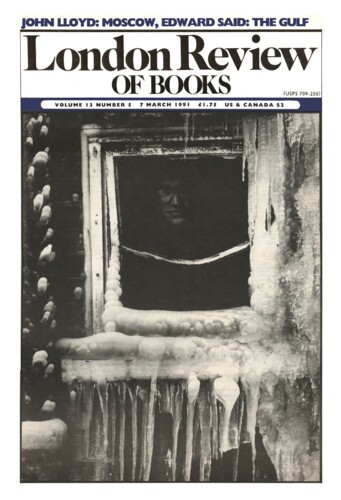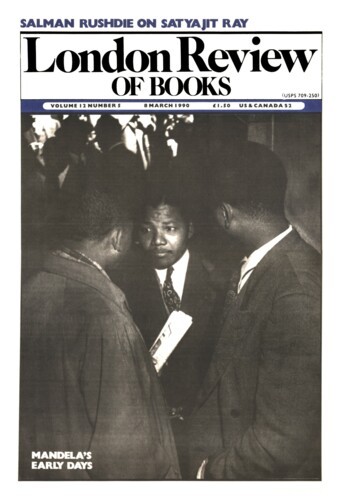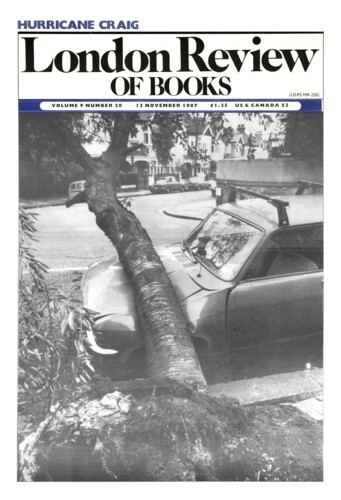James Fox
James Fox is currently engaged in writing a book about the murder of Lord Erroll.
Silly Buggers
James Fox, 7 March 1991
I first met Francis Wyndham in 1968, when I went to the Sunday Times Magazine looking for a job. A thunderstorm in the Gray’s Inn Road had soaked my cheap lightweight blue suit, bought in Johannesburg, and I was thinking my appearance had cost me my chance. At that time everyone – writers and photographers – seemed to want to write for the Magazine, then under the editorship of Godfrey Smith. It was both a serious and a very glamorous publication, soon to be the apogee of photo-journalism; its style was a vital part of the machinery of ‘the Sixties’ – all hard to imagine now. The newspaper itself was perhaps the best in the world, well financed, brimming with talent and zeal. Harold Evans had taken over as Editor the previous year.’
Diary: On Drum Magazine
James Fox, 8 March 1990
A week after Mandela’s release I got a call from Jim Bailey, my former employer on Drum Magazine in Johannesburg where I worked in the late Sixties. He had been elated by the news and set about gathering old Drum hands and sympathisers for a reunion. But by the time we met, he confessed to a sudden weariness, a kind of post partum depression after the forty years of toil and tension.
Poor Old Lucky
12 November 1987
Lucky’s Dip
James Fox, 12 November 1987
There is enough forensic evidence lying around to construct any number of theories, from either point of view. Was it, or was it not, Lord Lucan who murdered the nanny Sandra Rivett? In the 13 years since she was found in the US mailbag at 46 Lower Belgrave Street in London there has been no new evidence. Patrick Marnham’s only novelty is the evidence from Taki, the Spectator gossip-columnist, to the effect that he knew Lucky Lucan had a powerboat and had made dummy runs with an eight-stone sack to the coast. That fits with Lucan’s remarks to Greville Howard some weeks before the murder that he planned to drop his wife’s body into the Solent. As for the Lucan ‘set’, once so besieged and worried for its survival, this has long since been amalgamated into the Thatcher revolution. It’s a pity that neither of these books has a history of the store of rumour that grew up around the affair – the brutal witch-hunting stories that passed as truth, and are secure in the popular culture. They told us something of our rather nasty ways of dealing with the unexplained or inexplicable. It was indeed that line of venom which led me to ask about Lucan’s wife Veronica. These inquiries led in turn to a fierce reaction from the Lucan supporters, and to the hounding of Dominick Elwes. ‘They simply hadn’t realised what an unsympathetic appearance they gave to the rest of the world,’ writes Marnham.’
Pieces about James Fox in the LRB
Never Mainline: Keith Richards
Jenny Diski, 16 December 2010
I’m going to hang on to Keith Richards’s autobiography, because sometimes I worry that I lead a boring life and wonder if I shouldn’t try harder to have fun. When that happens,...
Waldorf’s Birthday Present: The Lovely Langhornes
Gabriele Annan, 7 January 1999
By the time she got married in 1895, Irene Langhorne was 22 and had had 62 proposals. Getting proposals was what Southern belles were brought up to do. Irene was the second of the five Langhorne...
Happy Valleys
Dan Jacobson, 18 November 1982
The story goes something like this. A ruthless aristocratic seducer of other people’s wives begins an affair with the bride (of a couple of months’ standing) of an acquaintance. The...
Read anywhere with the London Review of Books app, available now from the App Store for Apple devices, Google Play for Android devices and Amazon for your Kindle Fire.
Sign up to our newsletter
For highlights from the latest issue, our archive and the blog, as well as news, events and exclusive promotions.




